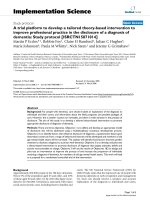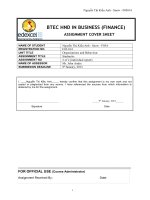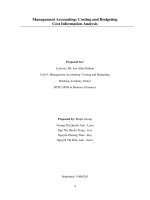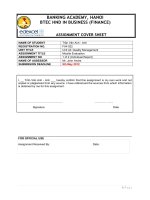Assignment 2 1620 Professional Practice Distinction
Bạn đang xem bản rút gọn của tài liệu. Xem và tải ngay bản đầy đủ của tài liệu tại đây (1.36 MB, 45 trang )
ASSIGNMENT 2 FRONT SHEET
Qualification
BTEC Level 5 HND Diploma in Computing
Unit number and title
Unit 3: Professional Practice
Submission date
27/03/2023
Date Received 1st submission
Re-submission Date
27/03/2023
Date Received 2nd submission
Student Name
Tran Duc Long
Student ID
GCH210562
Class
GCH1106
Assessor name
Do Manh Thai
Student declaration
I certify that the assignment submission is entirely my own work and I fully understand the consequences of plagiarism. I understand that
making a false declaration is a form of malpractice.
Student’s signature
Grading grid
P5
P6
P7
P8
M4
M5
D3
D4
Page 1 of 44
Summative Feedback:
Resubmission Feedback:
2.1
2.2
Grade:
2.3
Assessor Signature:
Date:
Internal Verifier’s Comments:
Signature & Date:
Page 2 of 44
Table of Contents
A.
INTRODUCTION ....................................................................................................................................... 6
B. DISCUSS THE IMPORTANCE OF TEAM DYNAMICS IN THE SUCCESS AND/OR FAILURE OF GROUP
WORK (P5). ..................................................................................................................................................... 6
I.
Definition of team dynamics ............................................................................................................... 6
II.
Characteristics of Team Dynamics that Make for a Winning Team .................................................... 7
III.
The importance of team dynamics in the success and/or failure of group work ........................... 7
IV.
In my group ...................................................................................................................................... 8
C.
4.1.
Success factor ............................................................................................................................... 8
4.2.
Failer factor .................................................................................................................................. 8
4.3.
Task Role: ..................................................................................................................................... 9
WORK WITHIN A TEAM TO ACHIVE A DEFINED GOAL (P6) .................................................................. 10
I.
Introduction of my group work ......................................................................................................... 10
1.
About the group............................................................................................................................. 10
2.
About the event ............................................................................................................................. 11
II.
My role in the group work ................................................................................................................. 12
III.
Result of group work ..................................................................................................................... 12
D. DISCUSS THE IMPORTANCE OF CPD AND ITS CONTRIBUTION TO OWN LEARNING (P7) ..................... 13
I.
Definition of CPD (continuing professional development) ............................................................... 13
II.
Why CPD importance ........................................................................................................................ 15
III.
CPD contribution to YOUR own learning ....................................................................................... 16
E.
OBJECTIVES AND REQUIRED SKILLS, KNOWLEDGE AND LEARNING FOR OWN FUTURE (P8) .............. 16
I.
II.
Setting goals ...................................................................................................................................... 16
2.1.
Short-term goals ........................................................................................................................ 17
2.2.
Long-term goals ......................................................................................................................... 17
Three skills need to develop ................................................................................................................. 18
2.1
Time management skills ............................................................................................................ 18
2.2
Communication skills ................................................................................................................. 19
2.3
Leadership skills ......................................................................................................................... 19
Page 3 of 44
III.
Strengths and weaknesses ............................................................................................................ 20
3.1
Weaknesses................................................................................................................................ 21
3.2
Strengths .................................................................................................................................... 22
IV.
Develop strengths and weaknesses .............................................................................................. 23
4.1
Develop strengths ...................................................................................................................... 23
4.2
Improve weakness ..................................................................................................................... 23
V.
Rating development needs ............................................................................................................... 25
VI.
Development plan ......................................................................................................................... 26
F. ANALYZE TEAM DYNAMICS, IN TERMS OF THE ROLES GROUP MEMBERS PLAY IN A TEAM AND THE
EFFECTIVENESS IN TERMS OF ACHIEVING SHARED GOALS (M4) ................................................................. 27
I.
Overview............................................................................................................................................ 27
II.
Roles of team member in team dynamics ........................................................................................ 28
III.
Summary ........................................................................................................................................ 30
G. COMPARE AND CONTRAST DIFFERENT MOTIVATIONAL THEORIES AND THE IMPACT THEY CAN HAVE
ON PERFORMANCE WITHIN THE WORKPLACE (M5).................................................................................... 30
I. Maslow’s Hierarchy of Needs ................................................................................................................ 31
II. Herzberg’s Two-Factor Theory/Motivator-Hygiene ............................................................................. 32
III. The Equity Theory ................................................................................................................................ 34
H. A CRITICAL EVALUATION OF YOUR OWN ROLE AND CONTRIBUTION TO A GROUP SCENARIO (D3) ... 37
I.
EVALUATE A RANGE OF EVIDENCE CRITERIA THAT IS USED AS A MEASURE FOR EFFECTIVE CPD (D4)
38
J.
CONCLUSION ......................................................................................................................................... 41
K.
CRITICAL EVALUATION .......................................................................................................................... 41
L.
I.
Strength ............................................................................................................................................. 41
II.
Weaknesses ....................................................................................................................................... 42
III.
Improvement ................................................................................................................................. 42
IV.
I look forward to my grade ............................................................................................................ 43
REFERENCE LIST..................................................................................................................................... 43
Page 4 of 44
Table of Figure
FIGURE 1: TEAM DYNAMICS (TEAMTECHNOLOGY, 2023) ............................................................................................ 6
FIGURE 2: PLACE CHOOSEN TO ORGANIZE EVENT ...................................................................................................... 12
FIGURE 3: TEAMWORK IS THE KEY TO SUCCESS ......................................................................................................... 13
FIGURE 4: CDP (JOHNSTON, 2021) ..................................................................................................................... 14
FIGURE 6: SETTING GOALS ................................................................................................................................... 17
FIGURE 7: TIME MANAGEMENT SKILLS ................................................................................................................... 18
FIGURE 8: COMMUNICATION SKILLS ...................................................................................................................... 19
FIGURE 9: LEADER SKILLS..................................................................................................................................... 20
FIGURE 10: STENGTH AND WEAKNESS ................................................................................................................... 21
FIGURE 11: WEAKNESS ...................................................................................................................................... 21
FIGURE 12: STRENGTH ....................................................................................................................................... 22
FIGURE 13: DEVELOP STRENGTHS ......................................................................................................................... 23
FIGURE 14: IMPROVE WEAKNESS .......................................................................................................................... 24
FIGURE 15: RATING DEVELOPMENT NEEDS ............................................................................................................. 25
FIGURE 16: MY RATING DEVELOPMENT NEEDS ......................................................................................................... 25
FIGURE 17: MASHOW'S HIERARCHY OF NEEDS........................................................................................................ 31
FIGURE 18: HERZBERG’S TWO-FACTOR THEORY/MOTIVATOR-HYGIENE ...................................................................... 32
FIGURE 19: THE EQUITY THEORY .......................................................................................................................... 34
Page 5 of 44
A. INTRODUCTION
In my assignment 1, my team and I discussed the actions we took to complete the "Gala dinner Connect together" project, which aimed to bring all members of our company together. Through
our self-assessment of the skills required for the project, we were able to identify both our areas
of proficiency and weaknesses, which will serve as evidence for the other members. This process
will help everyone to develop together in the future.
For the assignment 2, I will discuss the crucial connection between team dynamics and members'
behavior and how it significantly impacts the success of the "Gala dinner - Connect together"
project. Additionally, this report will delve into the factors that affect personal growth by setting
clear and specific goals for career advancement, both in the short and long term. This study also
covers the concept of CDP, which illustrates the process of growth and the potential outcomes
that can be achieved through continuous self-improvement.
B. DISCUSS THE IMPORTANCE OF TEAM DYNAMICS IN
THE SUCCESS AND/OR FAILURE OF GROUP WORK
(P5).
I.
Definition of team dynamics
Figure 1: Team dynamics (teamtechnology, 2023)
Team dynamics refers to the interaction and relationship among members of a team,
which can have a significant impact on how the team functions, performs, and achieves
its objectives. It involves the complex and interdependent factors that influence the
team's productivity, communication, collaboration, decision-making, conflict resolution,
and overall effectiveness. Team dynamics can be influenced by various factors, such as
Page 6 of 44
individual personalities, skills, and attitudes, team size, structure, leadership, culture, and
external environmental factors. Understanding and managing team dynamics is crucial for
promoting a positive team environment and achieving optimal performance and
outcomes. (teamtechnology, 2023)
II.
Characteristics of Team Dynamics that Make for a Winning Team
There are several key characteristics of team dynamics that are commonly associated
with high-performing, winning teams:
• Clear Goals: A winning team has a clear understanding of its goals and objectives, and
all team members are committed to achieving them.
• Communication: Effective communication is essential for a winning team. All team
members should feel comfortable sharing their ideas, concerns, and feedback openly
and honestly.
• Trust: Trust is a vital component of successful team dynamics. Members must trust
each other's skills, judgment, and intentions to work together effectively.
• Cooperation: A winning team functions as a cohesive unit, with all members working
together to achieve the team's goals. Each member's strengths and weaknesses are
recognized and leveraged to optimize performance.
• Accountability: Each team member should be accountable for their individual
contributions to the team's success. A winning team operates with a sense of
responsibility and ownership for its outcomes.
• Adaptability: A winning team is adaptable and able to adjust to changes in its
environment or circumstances. Members are flexible and open-minded, able to pivot
as needed to stay on track.
• Positive Attitude: Finally, a winning team has a positive, can-do attitude. Members are
motivated and committed to the team's success, maintaining a sense of enthusiasm
and energy even when faced with challenges.
III.
The importance of team dynamics in the success and/or failure of
group work
Team dynamics play a crucial role in the success or failure of group work. When team
members work well together, they can leverage each other's strengths, share ideas and
knowledge, and achieve better results than they could individually. Conversely, when
team dynamics are poor, communication breaks down, and conflicts arise, leading to
suboptimal performance, missed deadlines, and project failure. (Mindtools, 2023)
Effective team dynamics ensure that all team members have a clear understanding of
their roles, responsibilities, and goals. When roles and responsibilities are clearly defined,
and goals are aligned, team members can collaborate more effectively, reduce overlap,
Page 7 of 44
and work towards a common objective. Good team dynamics also foster open
communication, trust, and respect among team members, allowing them to share
feedback, ideas, and concerns, and to address conflicts constructively.
On the other hand, poor team dynamics can lead to a lack of trust, poor communication,
and decreased motivation. When team members do not feel heard or valued, they may
become disengaged, leading to lower productivity and performance. Conflicts and
disagreements can also arise when team members have different expectations, goals, or
opinions, leading to unproductive arguments and delays.
In summary, team dynamics are a critical factor in the success or failure of group work.
When team members work well together, communication is open and honest, and roles
and responsibilities are clearly defined, the team can achieve its goals and objectives
effectively. On the other hand, when team dynamics are poor, conflicts and
misunderstandings can arise, leading to suboptimal performance, missed deadlines, and
project failure. (Mindtools, 2023)
IV.
In my group
4.1.
Success factor
Success factor
Provide innovative suggestions.
Respect for all points of view
Adhere to the established principles
Everyone all treated fairly
Accept the distinction
4.2.
How to achieve it
In my group, we've developed a dynamic working
environment to encourage everyone's innovation.
We recognize that everyone's viewpoints are
important and should be listened and respected
into account when making decisions.
We established regulations and punishments for
members who broke those rules.
We recognize that each individual's viewpoint and
decision affects the work of the entire team.
When all issues are handled transparently, team
members can put their trust in one another and
operate with peace of mind.
Everyone learns to tolerate differences and not be
bothered by the work habits of some team
members simply because they are not the same.
Failer factor
Conflict is unavoidable in teamwork, thus we must occasionally spend more time
resolving differences. If we avoid conflicts, we have more time to complete the job rather
than dealing with controversies.
Page 8 of 44
During the project's implementation, the synchronization of opinions among the
members was poor, resulting in a lack of coherence in the project, which was a problem
for all groups, not just mine.
Distractions also happen frequently during project work, we usually intend to have a
break of about 30 minutes but actually we did it in more 1 hour. Sometimes social
networking sites also affect the concentration of members, but this is not too difficult to
handle.
4.3. Task Role:
Every member's position in my group is clearly defined and shown. Furthermore,
we encourage employees who want to challenge themselves by allowing them to
cycle and alter positions within the team. This fosters an environment in which
everyone may learn and grow, as well as develop a larger range of skills and
viewpoints.
Name
The role of member
Activities
Vu Thi Minh Ngoc
Follower, Opinion Seeker ,
Ngoc supervises team members in
Co-Ordinater
project implementation and
connects members with partners
such as introducing members,
sending contact information,
monitoring organizations,
decorating event spaces,
reviewing and edit the content
and time of the event. Support
members when having problems
at the venue such as power
failure, lack of game equipment.
Sa Duc Anh
Procedural Technician,
Duc Anh provides equipment for
Recorder
meetings such as laptops,
projectors, recorders, .... The
content of the meeting and
activities of the event such as
team building, gala dinner,
experiences he recorded.
He also supervises the technical
part of the event such as sound,
lighting, equipment such as
microphones, led screens. In
charge of liaising with equipment
suppliers to solve problems
promptly when equipment
malfunctions.
Page 9 of 44
Nguyen Thi Huyen
Trang
Opinion Giver, Harmornizer
Le Ba Chien
Information Seeker,
Commentator
- Give perspective on activities,
games and travel schedules during
the trip. Games such as blindfold
catching goats, jumping
sacks,....She arranges fun places
to go from far to near, such as
Monkey Island, Vinpearland,.... to
facilitate moving and withdrawing
short travel time.
- He provides information about
the location, restaurants, hotels,
and contact information of the
managers.
- He also gives suggestions for
event space decoration units and
gives decoration samples.
-Evaluate and highlight the
strengths and weaknesses of the
opinions people provide. He
objected to holding water games
because some people can't swim.
In my opinion, I believe that all the members are fulfilling their roles adequately. They assist and
collaborate with one another to ensure that the work is completed successfully. Additionally, we
make an effort to connect our roles and comprehend each other's responsibilities to foster
understanding and provide support. Overall, we work together effectively as a team and have
accomplished our project goals.
C. WORK WITHIN A TEAM TO ACHIVE A DEFINED GOAL
(P6)
I.
Introduction of my group work
1. About the group
Our group was established through the project "Gala dinner- Connect together"
implemented for all eployees in company. Our group is include 5 members: me (Tran
Duc Long), Vu Minh Ngoc, Nguyen Huyen Trang, Le Ba Chien, and Sa Duc Anh. Because
we were in the same class for more than a year, we understand each other's
personalities and attitudes, and the ability is pretty good. So the division of tasks is
quite easy.
Page 10 of 44
•
Our group chose Ngoc to be the Leader because of the dedication and
responsibility in the work, as well as its strong leadership. She is in charge of
assigning work to team members and meeting partners.
• A person who has a very good mathematical thinking ability, sense of humour, and
ability to resolve conflicts within team, Trang acting as my team's supervisor and
accountant.
• Duc Anh is the technician of his team, his task is to manage the equipment for the
event organization
• Chien is the group's secretary, he is in charge of recording and summarizing the
opinions of the members in each meeting of the group.
• I am looking for information and providing information in the group. It is my duty
to provide information on the status of restaurants and hotels so that the team is
no longer confused in finding the right hotel for the project.
In conclusion, each member of the team is responsible for adhering to the leader's
instructions and completing the task requirements. They all complete the task that
was assigned to them.
2. About the event
Name of the event: “Connect together”
Goals: The program will give the employees, managers:
• Strengthen the connection and exchange between departments,
employees and managers in the company.
• Summary of activities in the first 6 months of the year.
• Reward and motivate employees at work.
• Create a leisure time, relax after a working time.
Participant: 100 Managers and Senior Staff of Company.
Time: Wednesday 7 June - Sunday 11 June 2023.
Location: VinPearl Luxury Nha Trang, Hon Tre Island
Page 11 of 44
Figure 2: Place choosen to organize event
II.
My role in the group work
As an information seeker and information giver in our group, I believe that I have
consistently demonstrated a strong commitment to learning and sharing knowledge with
others. I take pride in my ability to seek out information from various sources and
synthesize it into meaningful insights that can benefit the group.
In my role as an information seeker, I approach every task with a sense of curiosity and
enthusiasm. I enjoy exploring new topics and researching them thoroughly to gain a deep
understanding of the subject matter. I am not afraid to ask questions and seek
clarification when necessary, and I always strive to go above and beyond in my efforts to
uncover relevant and useful information for this event.
As an information giver, I take great care to share my insights and knowledge in a clear
and concise manner. I believe that effective communication is key to ensuring that others
understand and can benefit from the information I am sharing. I am always willing to lend
a helping hand to my fellow group members and work collaboratively to achieve our
goals.
Overall, I believe that my dedication to learning and sharing knowledge has been a
valuable asset to our group. I am proud to be an information seeker and information giver
in my group and look forward to continuing to contribute to group's collective success.
III.
Result of group work
Page 12 of 44
Figure 3: Teamwork is the key to success
After a while, I joined my group to create the initiative "Connect Together." Teamwork gave us
with the information we required for my future career. Being the technical leader of my group is
something I never contemplated before joining the project. This was my first time in this job,
therefore I had some difficulties, but with the aid of the entire team, I progressively finished my
obligations.
I've honed a variety of skills, including communication, and I've progressively learned to set aside
enough time to complete my responsibilities.
Finally, with the team's drive and coordination to support one another, we were able to turn
barriers into motivations to achieve better. Throughout the event's planning and
implementation, all members of the team worked effectively together and contributed
significantly to the program's success. Each person is responsible for his or her function and
collaborates closely to reach a common goal. We've learned a lot from one another and are
proud of what we've accomplished in this event.
D. DISCUSS THE IMPORTANCE OF CPD AND ITS
CONTRIBUTION TO OWN LEARNING (P7)
I.
Definition of CPD (continuing professional development)
Continuing Professional Development (CPD) refers to the ongoing process of learning and
development that professionals engage in throughout their careers to maintain and
enhance their skills and knowledge. This could involve a range of activities, such as
attending conferences, workshops, and courses, engaging in self-directed learning,
participating in mentoring or coaching programs, and seeking feedback from colleagues
or clients. The aim of CPD is to ensure that professionals stay up-to-date with the latest
industry developments, best practices, and trends, and that they remain competent and
effective in their roles. CPD is typically a requirement for many professions, such as
Page 13 of 44
healthcare, law, education, and finance, and is often mandatory for maintaining
professional licensure or certification. (Johnston, 2021)
Figure 4: CDP (Johnston, 2021)
➢ CPD for Individuals:
• CPD for individuals refers to the process of ongoing learning and development that
professionals undertake on their own, outside of any employer-mandated training
or education. This could include attending conferences or workshops, reading
industry publications, taking online courses, participating in professional
associations, and engaging in self-directed learning. The goal of CPD for individuals
is to stay current with industry developments, trends, and best practices, to
enhance their skills and knowledge, and to stay competitive in the job market.
(Johnston, 2021)
• CPD for individuals can also help professionals to achieve their career goals,
whether that's advancing to a higher position, transitioning to a new field, or
developing a new set of skills. It can also help individuals to build their
professional network, establish their credibility within their industry, and improve
their job performance.
• It's important to note that CPD for individuals is not just limited to those who work
in regulated professions, but can be valuable for anyone looking to stay
competitive in their field and maintain their relevance in the job market.
➢ CPD for Organisations:
• CPD for organizations refers to the process of providing training and development
opportunities to employees to enhance their skills, knowledge, and performance.
This could include offering formal training programs, workshops, coaching,
mentoring, and on-the-job training.
Page 14 of 44
•
•
•
•
II.
The goal of CPD for organizations is to improve employee skills, knowledge, and
capabilities, which can lead to increased productivity, better job performance, and
improved business outcomes. CPD can also help organizations to attract and retain
talent, as employees are more likely to stay with an organization that invests in
their professional development.
CPD for organizations can take many forms, including online learning, classroombased training, and coaching or mentoring programs. It can be offered to all
employees or targeted to specific groups, such as new hires, managers, or highpotential employees.
Organizations that prioritize CPD often have a culture of learning and
development, which can lead to greater innovation, creativity, and adaptability. It
also helps to create a sense of shared purpose and engagement among
employees, as they feel valued and supported in their professional growth.
Overall, CPD for organizations is a strategic investment that can help to build a
more skilled and motivated workforce, which can lead to better business
outcomes and a competitive advantage in the marketplace. (Johnston, 2021)
Why CPD importance
CPD (Continuing Professional Development) is important for several reasons:
• Staying up-to-date with industry developments: CPD provides professionals with
opportunities to stay current with the latest trends, developments, and best
practices in their industry. This is essential to remain competent and effective in
their roles. (Anon, 2023).
• Enhancing professional skills and knowledge: CPD offers professionals the chance
to develop new skills and knowledge, which can help them to better perform their
job duties, achieve their career goals, and stay competitive in the job market.
• Meeting regulatory requirements: Many professions have regulatory bodies that
require professionals to complete a certain amount of CPD to maintain their
license or certification. Compliance with these requirements is essential to avoid
disciplinary action and to maintain professional standing.
• Improving job performance: CPD can help professionals to improve their job
performance by learning new techniques, tools, and best practices that can be
applied in their work. This can lead to increased productivity, better outcomes,
and higher job satisfaction.
• Building a professional network: CPD provides professionals with opportunities to
network with peers, mentors, and industry experts, which can help them to build
their professional reputation and establish themselves as experts in their field.
Page 15 of 44
III.
•
Career development: CPD can help professionals to achieve their career goals by
developing new skills, gaining new knowledge, and increasing their credibility
within their industry. This can lead to new opportunities for advancement and
career progression.
•
In summary, CPD is important for professionals to stay up-to-date, enhance their
skills and knowledge, meet regulatory requirements, improve job performance,
build a professional network, and achieve their career goals. (Anon, 2023).
CPD contribution to YOUR own learning
CPD's contribution to my own learning. Continuous Professional Development (CPD) can
significantly contribute to my own learning in several ways:
• Staying up-to-date: I am currently studying information technology at the
university of greenwich in Vietnam. My major requires me to stay up to date with
the latest trends and advancements in my field And CPD allows me to personally
do this, it helps me stay relevant and competitive in my profession.
• Acquiring new skills and knowledge: I have learned an amazing amount of
knowledge and important skills to help me advance my professional career from
two famous CPD programs: Project Management Professional (PMP) and
Microsoft Certified Systems Engineer (MCSE).
• Career advancement: CPD can improve my chances of career advancement. By
demonstrating a commitment to continuous learning and professional
development, I may be more likely to be considered for promotions and other
career opportunities.
• Meet regulatory requirements: In the IT industry I'm studying, a CPD is required to
maintain a license or certification. In these cases, I must participate in the CPD
programs necessary to maintain good standing and continue to practice in the
profession.
• Personal Growth: CPD can also contribute to my personal growth and
development. It can help me develop self-awareness, improve their
communication and leadership skills, and improve their teamwork.
Overall, CPD can have a significant impact on my personal career development, and it is
essential that I continue to learn and strive to develop my competence in the field of
information technology.
E. OBJECTIVES AND REQUIRED SKILLS, KNOWLEDGE
AND LEARNING FOR OWN FUTURE (P8)
I.
Setting goals
Page 16 of 44
Figure 5: Setting goals
A goal is a point in life that we work for, an intention, a direction that is presented to us,
and a motivator to urge our own effort. I must set a goal for myself because it is my
future. If I want to be successful, I need to set some goals for myself.
In order to achieve success in life, I've set a passion, a goal, and a clear path for myself to
pursue. Since then, I've devised a detailed technique for dividing distinct plans.
2.1. Short-term goals
Short-term goals Duration Start
Finish
Process Monitor
Note
Spend at least 2
hours a day
studying.
Complete 2
lessons in one
day.
Complete website
including html,
css, javascipt, and
php
Get a part-time
job and save at
least 2.5$ every
day
Practice code in 6
hours a day.
Complete react js
and php courses
on website
gokisoft.com
4 months
31/01/2023 30/04/2023
90%
Myselft &
gokisoft
Completing my
own sales website
fullstack
(Longtech)
Save money to
buy a new phone
1 months
01/04/2023 30/04/2023
90%
Myself
3 months
17/03/2023 17/06/2023
45%
Myself and my
family
Win the
greenwich best
student award
3 months
07/02/2023 07/05/2023
100%
Myself
2.2.
Long-term goals
Page 17 of 44
Short-term goals Duration
Start
Finish
Process Monitor
Note
Get a position in
FPT software
company
Buy a house and
car before
4 years
01/2021
01/2025
10%
Myself
10 years
01/2021
01/2031
5%
Myself & my
family
Get a scholarship
to study abroad at
Greenwich
University
5 years
07/2021
07/2026
10%
Myself
Focus on learning new
programing languages
and keep trying
Prioritize my studies
so that after
graduation I have a
stable job, then I can
make a profitable
investment.
Put learning first, try
to get Distinction
scores in every subject
I study whether hard
or soft skills are
important
II.
Three skills need to develop
2.1
Time management skills
Figure 6: Time management skills
Time management is a critical soft skill that involves planning and allocating
sufficient time to complete tasks effectively and efficiently. A successful time
management plan should be detailed and tailored to each specific period,
including clear deadlines and feasible assignments. It is crucial to have a
comprehensive and precise plan to manage time efficiently.
Time is a valuable resource that can’t be reversed, therefore it is crucial, I must
have a specific plan in place to manage it efficiently and prevent wastage.
However, I am still concerned about chasing time since I don't know how to make
the most of it or how to manage my job and life. As a result, I must establish
Page 18 of 44
specific goals and prioritize each task. When I have a certain goal in mind, I know
what I need to do to achieve it. Furthermore, creating a scientific work
atmosphere is a possibility. My office is scientifically arranged, so I don't have to
waste time looking for vital paperwork and records.
2.2
Communication skills
Figure 7: Communication skills
Having effective communication skills is essential for establishing business
connections and building personal relationships. Good communication skills
enable you to connect with others, gain their trust, and develop close bonds. In
contrast, poor communication skills can lead to misunderstandings and mistakes,
especially if complex language is used. Communication skills are considered soft
skills that involve the ability to listen actively, convey information clearly, interact
with others, and collaborate towards common goals. People with strong
communication skills can build multiple relationships, as their words have a
significant impact on those around them.
Despite the fact that my communication skills are above average, if not
exceptional. I do, however, want to make this knowledge into an art form. Because
communication is a two-way street involving two or more individuals, I need to
develop and enhance my listening skills. Learn to actively listen can also be rather
than imposing my beliefs on others. Understanding, empathy, and respect are all
examples of having an open mind, as are opening my heart to trust the other
person and openly discussing stories and facts.
2.3
Leadership skills
Page 19 of 44
Figure 8: Leader skills
Leadership skills refer to the aptitude of an individual to coordinate and manage tasks for
a group of people to achieve a common goal. Whether in a managerial position or leading
a project, having leadership skills is crucial in motivating and guiding others to carry out
their responsibilities within a designated timeframe. Leadership is a combination of
various soft skills, and not limited to a single trait. It requires having a clear vision and
principles, as well as the courage and competence to actualize it.
In my opinion, I consider myself a hesitant leader who lacks the ability to make sound and
accurate decisions. Therefore, I need to concentrate on improving my leadership skills in
the future. To achieve this, I need to practice making quick decisions in diverse situations
and gain supervisory experience in different environments. Additionally, I should not wait
for significant events to demonstrate my leadership potential but instead look for small
opportunities to showcase my abilities.
III.
Strengths and weaknesses
Every individual has their own set of strengths and weaknesses, and it is crucial to
acknowledge and address them in order to enhance ourselves. Strengths can be defined
as our natural abilities that allow us to perform tasks with ease and efficiency. On the
other hand, weaknesses are areas that require improvement and may not be as
proficient. It is important to recognize that everyone possesses both strengths and
weaknesses, and they can be improved through intentional effort and dedication.
Page 20 of 44









